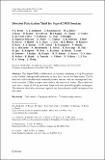Browsing MIT Open Access Articles by Author "Saab, T."
Now showing items 1-10 of 10
-
Dark matter effective field theory scattering in direct detection experiments
Schneck, K.; Cabrera, B.; Cerdeno, D. G.; Mandic, V.; Rogers, H. E.; e.a. (American Physical Society, 2015-05)We examine the consequences of the effective field theory (EFT) of dark matter–nucleon scattering for current and proposed direct detection experiments. Exclusion limits on EFT coupling constants computed using the optimum ... -
Detector Fabrication Yield for SuperCDMS Soudan
Brink, P. L; Balakishiyeva, D.; Bauer, D. A; Beaty, J.; Brandt, D.; e.a. (Springer US, 2014-02)The SuperCDMS collaboration is presently operating a 9 kg Ge payload at the Soudan Underground Laboratory in their direct search for dark matter. The Ge detectors utilize double-sided athermal phonon sensors with an ... -
First Direct Limits on Lightly Ionizing Particles with Electric Charge Less than e/6
Agnese, R.; Balakishiyeva, D.; Basu Thakur, R.; Bauer, D. A.; Billard, Julien; e.a. (American Physical Society, 2015-03)While the standard model of particle physics does not include free particles with fractional charge, experimental searches have not ruled out their existence. We report results from the Cryogenic Dark Matter Search (CDMS ... -
Improved WIMP-search reach of the CDMS II germanium data
Agnese, R.; Asai, M.; Balakishiyeva, D.; Barker, D.; Basu Thakur, R.; e.a. (American Physical Society, 2015-10)CDMS II data from the five-tower runs at the Soudan Underground Laboratory were reprocessed with an improved charge-pulse fitting algorithm. Two new analysis techniques to reject surface-event backgrounds were applied to ... -
Low-mass dark matter search with CDMSlite
Agnese, R.; Anderson, A. J.; Aralis, T.; Aramaki, T.; Arnquist, I. J.; e.a. (American Physical Society, 2018-01)The SuperCDMS experiment is designed to directly detect weakly interacting massive particles (WIMPs) that may constitute the dark matter in our Galaxy. During its operation at the Soudan Underground Laboratory, germanium ... -
Maximum likelihood analysis of low energy CDMS II germanium data
Agnese, R.; Balakishiyeva, D.; Basu Thakur, R.; Bauer, D. A.; Borgland, A.; e.a. (American Physical Society, 2015-03)We report on the results of a search for a Weakly Interacting Massive Particle (WIMP) signal in low-energy data of the Cryogenic Dark Matter Search experiment using a maximum likelihood analysis. A background model is ... -
New Results from the Search for Low-Mass Weakly Interacting Massive Particles with the CDMS Low Ionization Threshold Experiment
Agnese, R.; Anderson, A. J.; Aramaki, T.; Asai, M.; Baker, W.; e.a. (American Physical Society, 2016-02)The CDMS low ionization threshold experiment (CDMSlite) uses cryogenic germanium detectors operated at a relatively high bias voltage to amplify the phonon signal in the search for weakly interacting massive particles ... -
Projected sensitivity of the SuperCDMS SNOLAB experiment
Agnese, R.; Aramaki, T.; Arnquist, I.; Baker, W.; Barker, D.; e.a. (American Physical Society, 2017-04)SuperCDMS SNOLAB will be a next-generation experiment aimed at directly detecting low-mass particles (with masses ≤10 GeV/c^{2}) that may constitute dark matter by using cryogenic detectors of two types (HV and iZIP) and ... -
Search for Low-Mass Weakly Interacting Massive Particles with SuperCDMS
Agnese, R.; Asai, M.; Balakishiyeva, D.; Basu Thakur, R.; Bauer, D. A.; e.a. (American Physical Society, 2014-06)We report a first search for weakly interacting massive particles (WIMPs) using the background rejection capabilities of SuperCDMS. An exposure of 577 kg days was analyzed for WIMPs with mass < 30 GeV/c[superscript 2], ... -
Update on the Micro-X Sounding Rocket payload
Figueroa-Feliciano, Enectali; Adams, J. S.; Baker, R.; Bandler, S. R.; Dewey, Dan; e.a. (Society of Photo-Optical Instrumentation Engineers (SPIE), 2012-09)The Micro-X High Resolution Microcalorimeter X-ray Imaging Rocket is a sounding rocket experiment that will combine a transition-edge-sensor X-ray-microcalorimeter array with a conical imaging mirror to obtain high- ...









